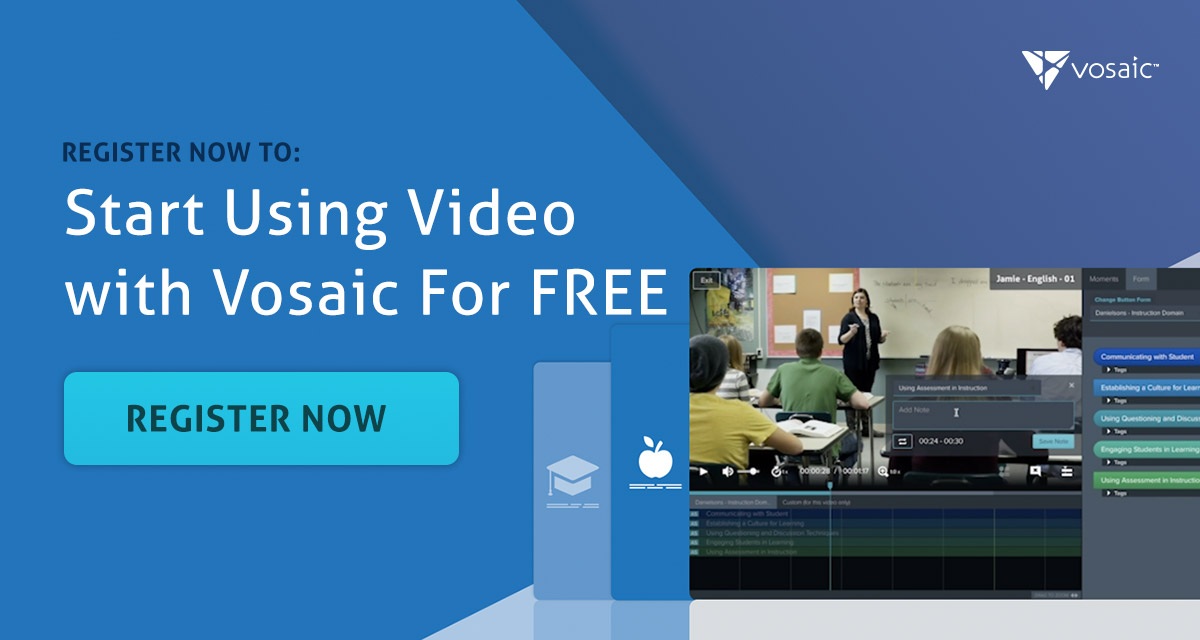Table of Content
- What is Goal Setting Theory?
- The Research and Metrics of Today
- Danielson’s Goal-Setting Example
- About Vosaic's AI-powered Video Platform for Teacher Coaching
We’ve got effective research on how to improve student behavior, approaches for integrating social-emotional learning, methods for getting students talking in class (and teachers talking less), and processes for supporting neurodiverse students.
But all this information is useless if we are incapable of putting it into practice. We all know that goal setting is important, but what are the best practices for setting and carrying out those goals? Research on Goal Setting Theory is often referred to as a standard for setting and achieving great goals, but how does it stack up to current systematic reviews of the literature?
What is Goal Setting Theory?
Goal Setting Theory, as researched by Dr. Edwin Locke and Dr. Gary Latham and published in “A Theory of Goal Setting and Task Performance,” in 1990, generally refers to the following goal-setting principles that improve goal-reaching success rates.
Clarity
Getting specific with your goal motivates you to achieve it and helps you know exactly when you have achieved it, giving you a hit of dopamine.
Unclear goal: I will improve my ability to monitor and adjust instruction.
Clear goal: I will improve my ability to monitor and adjust instruction by implementing a wait time of 15 seconds in class and giving academic feedback to students.
Challenging, but not too complex
Make your goals challenging enough to interest you, but not so complex that your initial reaction to them is fear or indifference.
Challenging goal: I will learn and incorporate ELL research-based strategies in the learning environment by phasing in one principle per week.
Unchallenging goal: I will learn and incorporate ELL research-based strategies in instruction and the learning environment by tomorrow.
Feedback
Feedback allows you to consider how you are progressing towards your goals, whether the feedback is external or achieved through self-reflection. However, feedback can be inaccurate. Human error is inevitable, and it can be difficult to give factual and specific feedback. In addition, how we think we performed a task and how we actually performed it is often inconsistent, invalidating self-reflection practices.
Commitment
Goals that meet all the previous criteria have the best chance of garnering commitment. When teachers set their own goals, they are more likely to stay committed.
The Research and Metrics of Today
The research of today doesn’t disagree with Locke and Latham’s work, but touches on some additional and varying factors that have positive implications for goal setting. On September 11, 2022, A Systematic Review of Goal Setting and Performance Feedback to Improve Teacher Practice was published. This condensed research is invaluable to professors, teacher candidates, principals, administrators, and teachers everywhere!
According to the research, performance feedback, arguably the weakest arm of Goal Setting Theory, is essential to aggregate teacher commitment to goals and goal setting. Here, we’ve listed the identifiable aspects of performance feedback and goal setting that were shown to have the greatest impact on reaching goals.
4 Most Important Teacher Goal-Setting Metrics
1. Visual Presentation of Data
Outside pressure or even suggestion cannot force reflection. By removing anecdotal evidence, and instead presenting only what can be physically observed, we leave room for teachers to discover growth areas independently.
Present visual data through the use of video to reduce the dissonance between how teachers think a lesson went, and how it actually went. This will increase their internal motivation to improve and stimulate self-reflection. Depending on what video analysis platform you use, you can even visually see metrics like teacher talk time or a transcript of what was said in class.
2. Teacher-Created Goals
Guide your teachers and pre-service teachers with coaching and visual data to help them make decisions about their goals, but then allow them to create those goals themselves. A sense of ownership over one's goals is a motivating factor in reaching them!
3. Measurement of Progress Toward Goals
Measurement of progress has everything to do with the specificity of the goals you’ve set, as was explored in Goal Setting Theory. It’s simple to determine whether you’ve met your goals if they’re specific. But beyond knowing if you’ve reached your goals, how do you measure progress toward them?
The best way is to use a video analysis tool to compare a few videos across time, looking for the same behaviors you’re trying to improve in each. Using a timeline within the tool, you can visually see whether you are making progress.
Additionally, Vosaic's AI feature will give you initial feedback right after you upload the video.
4. Discussion of Goals During Feedback
“Talking it out” with a coach or professor is one of the best ways to continue improving your practice, especially for verbal processors. However, if you can’t align schedules for an in-person coaching session, don’t just settle for typed comments attached to the video of your teaching. Instead, opt for video comments, like those offered on Vosaic’s platform. Video comments include a personal element that is much more encouraging.
Danielson’s Goal-Setting Example
Let’s see what goal-setting and performance feedback look like using a common and effective rubric: Danielson Framework for Teaching, The Framework for Teaching Clusters.
Step One
First, a teacher or teacher candidate must get clear about what their goals are. This might entail learning all they can about Danielson’s Framework before getting started. They make their goal challenging, but not too complex. Teachers may want to work with coaches (or professors) to accomplish this. Together, a coach and teacher determine that what the teacher most needs to improve is “fostering a learning environment conducive to learning”, which is housed in Cluster 2 of Danielson’s Framework. Next, the teacher and coach decide to get even more specific. The teacher will focus on “asking for clarification and elaboration” when students present ideas over the next three classes.
Step Two
Next, the teacher sets up their video camera (like their laptop or even smartphone) to record their class. They attempt to implement “asking for clarification and elaboration” throughout the next three classes.
Step Three
The teacher can now upload the videos to Vosaic’s video analysis platform, self-reflect on what they see, and mark up the videos for any moments where they “ask for clarification and elaboration” throughout the lesson. The teacher can also see if they made any progress between video 1 and video 3 to check for incremental improvements.

Step Four
After self-reflection, the teacher can share the videos with their coach directly on Vosaic. The coach can additionally mark up the video and leave text or video comments that correspond with moments on the timeline. The teacher and coach can also meet in person to review the video together and discuss further steps. The teacher and coach in this case decide that sufficient progress has been made and create an additional goal for the teacher. Next time, the teacher will work on “displaying sensitivity to students’ feelings” throughout the class.
About Vosaic
Vosaic’s cloud-based AI-powered video platform is used to help teachers, pre-service teachers, and professionals bridge the gap between theory and practice. Easy-to-use video recording, commenting, and sharing enables users to more effectively observe, coach, and mentor. Teachers and coaches can upload, record, and share videos for evaluations, feedback, self-reflection, and so much more.




